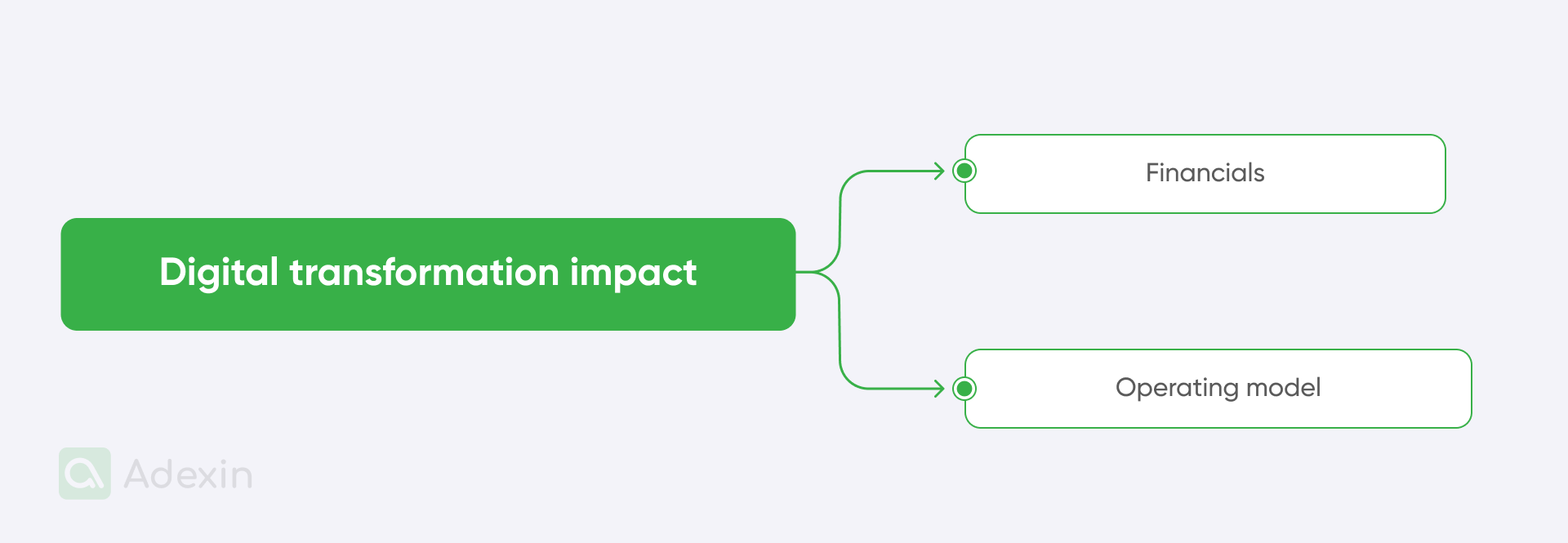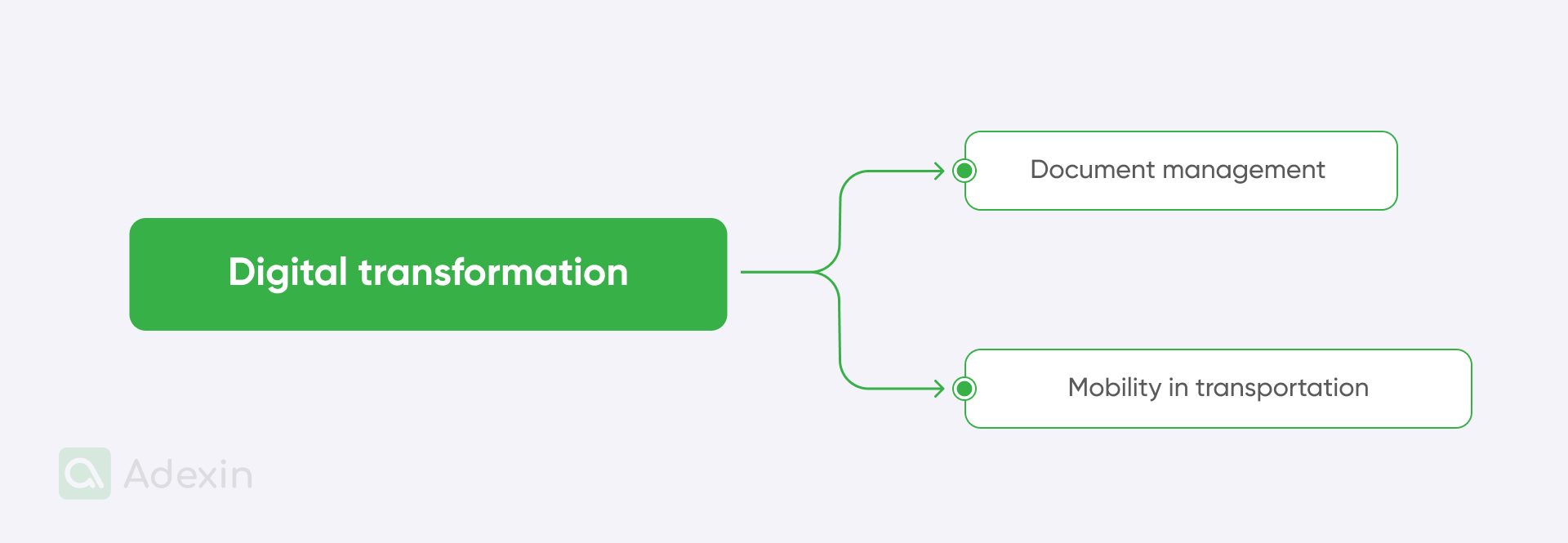When we consider business development today, the first element on our path is software embedded in our business operations. We are considering improving document management and will then integrate a document management system (DMS). When we think about transportation, we integrate a fleet management system (FMS) with a warehouse management system (WMS), and so on.
Naturally, digital transformation is becoming increasingly important from several perspectives. One of those is that companies want to remain more competitive. Others are related to the fact that global businesses are pushed by governments towards green policies to become more efficient in terms of the environment and to mitigate issues arising from extensive CO2 pollution. For these and many other reasons, you must embrace digital transformation; otherwise, outdated solutions will impede your business.
The impact of digital transformation on logistics and supply chain business is undoubtedly significant, and companies should take precautions to avoid falling behind. Simply put, if your competitors invest in digital solutions, they can secure more deals in the future.
Digital transformation impact on business: digital technologies
When considering the impact of digital transformation, we should shift our focus towards increased efficiency by using digital technologies. The primary objective in transforming your operations with digital solutions is to enhance business performance. Investing in digital technology is akin to any other investment, with your business highly focused on ROI and revenue analysis. As we have previously discussed in our blog, tangible and intangible values can be derived from any investment.
Businesses operating in logistics, supply chain, or transportation will realize the value of their investments in different ways compared to other industries. However, by focusing on these sectors, we can provide direct examples of the economic potential of digital transformation in the supply chain.
For instance, investing in autonomous supply chain technology could involve deploying autonomous vehicles to support warehouse operations. Implementing digital technology in planning can optimize inventory management, potentially reducing inventory levels by 10 to 20 percent while still meeting required service levels. In essence, the entire organization becomes more agile and customer-centric, leading to a 3 to 4 percent increase in revenue.

Here are the areas where digital transformation is impacting business with digital technologies:
Financials and digital technologies
Moving towards digital transformation impacts sales processes, sometimes increasing sales from 40% to 70% advantages. It is obvious in the e-commerce market that companies simultaneously integrate various technologies more tightly with distribution management and the goods cycle.
Operating model: shift towards traditional business models
Digital transformation helps with more efficient resource usage and improves the management model. It ensures lower consumption of resources through better planning, creating a more focused business roadmap that specifies specific needs in business complexity. Resource usage also involves managing company staff planning and asset management more efficiently, impacting a more sustainable business approach.
Top 5 components of digital transformation
Digital transformation will be more or less complex for each industry, which will also depend strictly on the expectations that arise from such shifts in the organization. In some exceptional cases, when a company is adapting a software solution, it is important to consider entities that comprise the business network and interconnect with each other.

When digital transformation involves updating hardware solutions such as robotics and automation in warehouses, the expectations are heightened. Depending on the business needs, we can identify five components that are crucial in the journey of digital transformation.
1. Digital strategy
A comprehensive digital strategy serves as a framework to lead the organization's digital transformation. It defines the overall goals, objectives, and initiatives needed to successfully leverage digital technologies.
Under this component, your organization must define its digital transformation vision. Very often, it involves identifying key performance indicators (KPIs) to measure and define a successful path. You strategically allocate resources and establish an implementation plan. It can be handled more effectively when you use consultancy services that can provide you with a more robust digital strategy. In fact, when it comes to software deployment, custom software development companies can often help in creating a strategy aligned with your niche. They can support much better in changing market trends and with technological advances.
2. Data management
Data is at the core of digital transformation. You need it for informed decision-making. Effective data management involves collecting, storing, processing, analyzing, and leveraging data assets to produce actionable insights and achieve business results.
This component includes implementing a robust data management framework to ensure data quality, security, and compliance. If you consider professional data management, you need to leverage advanced analytics and artificial intelligence (AI) technologies to unlock the full potential of data.

3. Innovation
Innovation is essential for continuous improvement and staying ahead of the competition in the digital age. This component includes these sub-elements:
Promotion of a culture of innovation within the organization
Fostering creativity among teams
Getting on the experimentation and risk-taking path
Providing resources and support for innovation initiatives
Establishing cross-functional innovation teams
Emphasizing customer-centric innovation strategies
Encouraging knowledge sharing and collaboration
Investing in research and development of emerging technologies
It is a highly individual aspect of each organization and involves leveraging new technologies to develop more innovative solutions, products, and services. In doing so, companies can better meet evolving customer needs and market demands, driving sustained success in the dynamic digital landscape.
4. Software and technology
Digital transformation is the integration of digital technology into all areas of a company. This approach results in fundamental changes in operations. Organizations benefit from modernizing legacy processes, accelerating workflows, strengthening security, and increasing profitability.
For example, nearly 90% of companies operate in the cloud today and 70% will employ hybrid or multi-cloud management technologies, software tools, and processes. This figure shows that true digital transformation goes beyond replication to create a transformational framework. Software and technology transform services and data into useful information sources, improving every aspect of the organization.
Instead of simply migrating data, in many cases, custom software applications can use transformation to optimize systems for interoperability and flexibility. This results in what is called robust business intelligence, positioning the company for future success in an ever-evolving digital landscape
Digital transformation for software and technology is about:
Integration of digital technology into all business areas.
Results in fundamental operational changes.
Modernizing processes, accelerating workflows, strengthening security, and increasing business profitability
5. People
The human factor is integral to the success of digital transformation initiatives. This component focuses on empowering employees, developing digital skills, and cultivating a mindset of continuous learning and adaptation.
This entails providing appropriate training and development opportunities to upskill existing talent in digital technologies and methodologies. There is no doubt that organizations must prioritize effective change management practices to counter resistance to change and ensure the widespread adoption of digital initiatives at all levels of the organization.
The aspect of the human factor is also a challenge in digital transformation, closely described in the next part of this article.
What are the challenges of digital transformation?
Up front of everything, what we can say about digital transformation is crucial to move the focus toward business challenges. We outline here where exactly your organization can expect to be challenged while adopting digital technology. We need to emphasize this concerning the industries that are in our niche.

Transformation of customer service
For many, it can be questionable why we put it on the top CUS as the main subject that should be well evaluated. This is because we believe in a centric customer approach where the forefront of all options should strictly focus on the customer experience, so in fact, we focused on how we handle certain issues. According to KPMG, transforming customer service is a key turning point in business development and is a vast part of digital transformation.
When we look from the perspective of digital transformation in the organization, such as logistics, supply chain, and transportation, we can clearly see that we can face many issues that can directly affect customer relationships. We see this as a major challenge that should be overcome, where adapting new technologies also impacts these operations, but in a positive way.
The level of customer service can be leveraged by developing a highly customized CSM system or, however important it is, a CRM system that is integrated with other logistics and supply chain means.
For example, a customized CRM system that is integrated with a warehouse management system and fleet management system can do for you as follows:
Provide automated and fully digital POD (proof of delivery) on mobile devices
Generate and send automated shipping documents such as CRM, Commercial invoices (which will be a vast part of financial systems), packing lists, etc.
Plan and schedule your shipment as well as loading space to cut shipping costs
Communicate via API with external customs systems to provide a Certificate of Origin
Provides customers with real-time updates and information.
Improves transparency, reliability, and trust in customer relationships
Deliver regular monitoring and optimization of systems to meet growing customer needs
Enable agile response to feedback and market dynamics for sustained customer satisfaction
Employ machine learning for dynamic routing
Integrate blockchain for transparency to enhance trust and streamline processes
All that information can be provided directly and in an automated way to customers to maintain the highest transparency and secure your relationships.
Ensuring data security and privacy
Data security and privacy, while companies are on the digital transformation journey, is about keeping the business areas secured against breaches that can affect coordination between departments. We know that handling data today should be maintained with the highest attention, and system architecture for data handling should be well-designed to prevent companies from losing their assets.
We're on the eve of metadata these days, where the future of augmented analysis of data using all the relevant data sources is accessed with digital transformation by advanced analytics. Companies heavily invest in customization with strong system data engines, based on AI orchestration, adaptive practices, and metadata analysis.
Maintaining the highest level of data sanity is required from companies' high programming skills and technology knowledge. Combining these two elements seems to be most challenging when we want to cope with data security and privacy requirements. Why is it so difficult? Simply put rapid software and technology development don’t allow businesses to keep these qualities in-house.
It is very resource-consuming and expensive to keep software development and automation experts from robotics in-house while we adapt to new, digital technologies. We already care about built-in security and compliance that enables the safe shipping document management platform. This was a truly significant step for the company in transportation & logistics that used our custom software development services.
Need help with document management systems development?
Learn how we can boost your business processes
Explore moreInternal resistance to change
In many companies, personnel such as business analysts and managers responsible for continuous improvement processes are facing diligent obstacles in shifting internal culture. The challenge in adapting new technologies isn’t only technical; it's also related to the human factor, where we need to take care of personnel skills, and training, and leverage collaboration between teams.
In terms of digital transformation, resistance to change is often perceived through the perspective of personnel who are not able to adapt quickly, which often boils down to problems with innovation development. This is a strict human resources challenge and can pose many risks in temporarily losing business operability caused by the shortages of qualified staff.
The best way to overcome this issue is to set a clear path for training and personnel development with clearly diversified task schedules and responsibilities. In many cases, when we adopt a new technology such as a software solution, we can rely solely on the support from well-qualified custom software development companies. Here is where custom software development companies can help with overcoming the challenge of resistance to change:
Providing clear technical documentation
Taking care of staff training
Providing ongoing support and consultancy to the organization
How does digital transformation affect organizations?
Relying on our experience in logistics software development, transportation, and supply chain operations, we have captured the most essential elements of how digital transformation affects organizations in these industries. We have observed that companies aiming to be more customer-centric are eager to provide unique business value through custom software development. This approach allows these organizations to obtain highly relevant solutions to cope with market demand better.
When we think about digital transformation, companies should take many precautions, and trends shouldn't always promise the best results and yield innovation demands. In our experience, this is how we've learned that it is important to guide companies beyond the hype and focus on specific business needs. We have already facilitated our business approach, which helps companies gain much more significant advantages from our offerings based on custom software development.

Here are the areas where companies were able to gain:
Document management and digital technology
Managing and digitizing documents in today's logistics, transportation, and supply chain poses incredible challenges. The diversity of documents covering both inbound and outbound processes, where shipping operations alone require multiple document workflows to ensure timely delivery to the correct destination, creates many problems in these industries.
We address the challenge of shipping documents by implementing a paperless system and standardizing document procedures. Through efficient data transfer and eliminating data exploitation risks, we tap into what McKinsey refers to as a hidden source of value.
Our team worked on solutions that not only optimize print and document services but also master document ingestion with a technology stack that includes:
Digital tools based on Golang (Go). Go is a programming language known for its efficiency. This language makes custom software ideal for creating high-performance back-end systems for document management.
Node.js. An open-source platform for working with the JavaScript language, built on the Chrome V8 engine. It allows you to write server-side code for web applications and dynamic web pages, as well as command-line programs.
GraphQL. Digital technology GraphQL offers a flexible approach to data queries, allowing document management systems to retrieve only the required information from the database.
PostgreSQL. PostgreSQL is a reliable and feature-rich database management system suitable for storing and managing large amounts of document data helping with digital transformation.
Docker. Docker makes it easy to develop and deploy document management systems by encapsulating them in lightweight, portable containers.
Digital transformation with mobility in transportation
Today, transportation cannot function without access to mobile solutions. We need to gain more control over ongoing processes to better meet the evolving requirements of transportation, which increasingly rely on the expertise of individual truck drivers.
Considering the challenges faced by truck drivers, we observed that one business was encountering specific issues with document scanning as it evolved. The truck owners' assistance mobile application we worked on involved utilizing custom software and open-source libraries to enhance mobile scanning capabilities. We integrated features such as document detection, automatic cropping, contrast adjustment, and black-and-white conversion into a mobile app.
Need help with custom mobile app development?
Learn how we can boost your logistic business processes
Explore moreThese technologies have been instrumental in addressing the identified challenges, we are already using them to create applications in the logistics industry:
C#. A versatile programming language commonly used with the .NET framework to develop various applications.
.NET. Microsoft's framework for developing various applications, including mobile applications, has rich libraries and tools.
Xamarin digital technology. A cross-platform development platform for creating mobile applications using the C# language and a joint code base for Android, iOS, and Windows.
JavaScript. In web development, JavaScript is commonly used in frameworks such as React Native to create cross-platform mobile apps.
React Native. used to develop applications for Android, Android TV, iOS, macOS, tvOS, Web, Windows, and UWP by enabling developers to use the React framework along with native platform capabilities.
Mobile interface development with Flutter. An open-source framework for creating mobile applications for Android and iOS, web applications, and desktop applications for Windows, macOS, and Linux using the Dart programming language, developed and developed by Google.
AWS (Amazon Web Services). Offers cloud computing services used in mobile application development for data storage, serverless processing, and user authentication.
Get higher customer satisfaction with OpenCV. A computer vision library is used in mobile applications for image processing, object recognition, and augmented reality tasks.
Benefits of digital transformation
Digital transformation affects organizations in various ways. By looking closer through the lens, we have observed that business today is more beneficial in these areas of the business.

Here are ground statistics and examples of digital transformation:
Operational efficiency. 35% of companies that strive for digital transformation are successful. These figures highlight the potential for improved operational efficiency through successful digital transformation initiatives.
Improved customer experience. 97% of companies state that the COVID-19 pandemic has accelerated their digital transformation initiatives. This figure shows that there is a greater focus on improving the customer experience via the digital channel.
Data-driven decision making. 72% of data and analytics leaders are either leading or heavily involved in their organization's digital transformation. This undoubtedly underlines the importance of data-driven approaches to transformation initiatives.
Agility and innovation. Cloud, artificial intelligence, and the Internet of Things are used by up to 45% of companies in their respective industries. This shows that investment in technology offers opportunities to drive agility and innovation in organizations.
Scalability and flexibility. The market for digital transformation is expected to reach 3.74 trillion US dollars by 2030. This underlines the scalability and growth potential of digital transformation initiatives.
Improved collaboration and communication. 86% of companies believe that workplace transformation leads to better collaboration between teams. We see that this highlights the role of digital tools in fostering better communication and collaboration.
Are you in search of a reliable tech partner?
Adexin can help with advanced logistics solutions
Contact usSummary: implementing digital transformation
Digital transformation is having a significant impact on organizations. The need for change is particularly evident in sectors critical to the national and global economy, such as logistics, transportation, and supply chain.
Organizations that embrace digital transformation can gain significant benefits but they must develop particular digital skills, which can help them better use emerging technologies.
Adexin, a custom software development company, helps companies create mobile solutions tailored to specific industry needs. We deliver tangible value that helps companies further demonstrate digital innovation. Stay competitive and responsive to changing market demands. Contact us for more information on the strategic priority of digital transformation.

